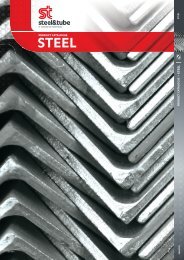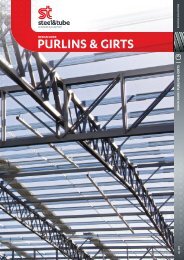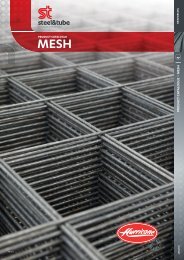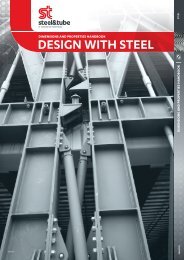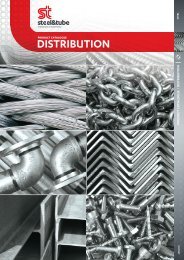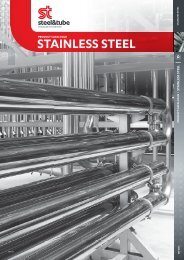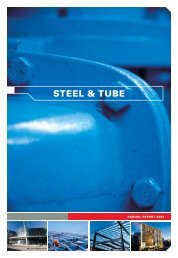DIMENSIONS
DIMENSIONS & PROPERTIES - Steel & Tube
DIMENSIONS & PROPERTIES - Steel & Tube
- No tags were found...
Create successful ePaper yourself
Turn your PDF publications into a flip-book with our unique Google optimized e-Paper software.
CCI<br />
conversion<br />
and<br />
comparison<br />
information<br />
Hardness Testing<br />
The hardness of a given material is generally defined as the resistance it shows to penetration by a test body<br />
of defined shape. It can be measured with testing equipment of different design, the most common types<br />
being Brinell, Rockwell and Vickers.<br />
Brinell hardness and Vickers hardness are expressed by the quotient of load and surface area of indentation.<br />
The hardness numbers for Brinell and Vickers hardness are not affected by the introduction of Newton as unit<br />
of force. It has been internationally agreed to simply multiply the load with the factor 0.102.<br />
Example: Old new<br />
HB =<br />
A<br />
F<br />
HB = 0.102<br />
A<br />
F<br />
Load F in kp<br />
Load F in N<br />
Surface area of permanent indentation A in mm 2<br />
The following comparison of hardness tables are based on DIN 50 150 of December 1976. Values in bold face<br />
correspond exactly to DIN values. The other values are interpolated. Values in parenthesis are values outside<br />
the defined range of standardised hardness testing procedures. Also, Brinell hardness numbers in parenthesis<br />
apply only when testing with carbide ball.<br />
The tables cover only hot formed or heat treated, unalloyed or low alloy steels and steel castings.<br />
Interconversion of hardness numbers or conversion of hardness numbers to tensile strength values is subject<br />
to error and should only be employed when prescribed testing procedure is not applicable.<br />
(Tests carried by Verein Deutscher Eisenhüttenleute [VDEh] showed a scatter range for the conversion of<br />
Vickers hardness numbers to tensile strength values of ±25 HV 10 or ±85 N/mm 2 .)<br />
Comparison of Hardness<br />
Tensile<br />
strength<br />
N/mm 2<br />
Vickers<br />
hardness<br />
(F > 98 N)<br />
HV<br />
Ball<br />
indentation<br />
diameter 1<br />
mm<br />
Brinell<br />
hardness 2<br />
HB<br />
HRB<br />
Rockwell hardness<br />
HRC<br />
200<br />
210<br />
220<br />
63<br />
65<br />
69<br />
7.32<br />
7.22<br />
7.04<br />
60<br />
62<br />
66<br />
225<br />
230<br />
240<br />
70<br />
72<br />
75<br />
6.99<br />
6.95<br />
6.82<br />
67<br />
68<br />
71<br />
250<br />
255<br />
260<br />
79<br />
80<br />
82<br />
6.67<br />
6.63<br />
6.56<br />
75<br />
76<br />
78<br />
270<br />
280<br />
285<br />
85<br />
88<br />
90<br />
6.45<br />
6.35<br />
6.28<br />
81<br />
84<br />
86<br />
41<br />
45<br />
48<br />
290<br />
300<br />
305<br />
91<br />
94<br />
95<br />
6.25<br />
6.19<br />
6.16<br />
87<br />
89<br />
90<br />
49<br />
51<br />
52<br />
310<br />
320<br />
330<br />
97<br />
100<br />
103<br />
6.10<br />
6.01<br />
5.93<br />
92<br />
95<br />
98<br />
54<br />
56<br />
58<br />
1<br />
steel ball with 10mm diameter<br />
2<br />
calculated from: HB = 0.95 HV<br />
102<br />
Dimensions and Properties Handbook



